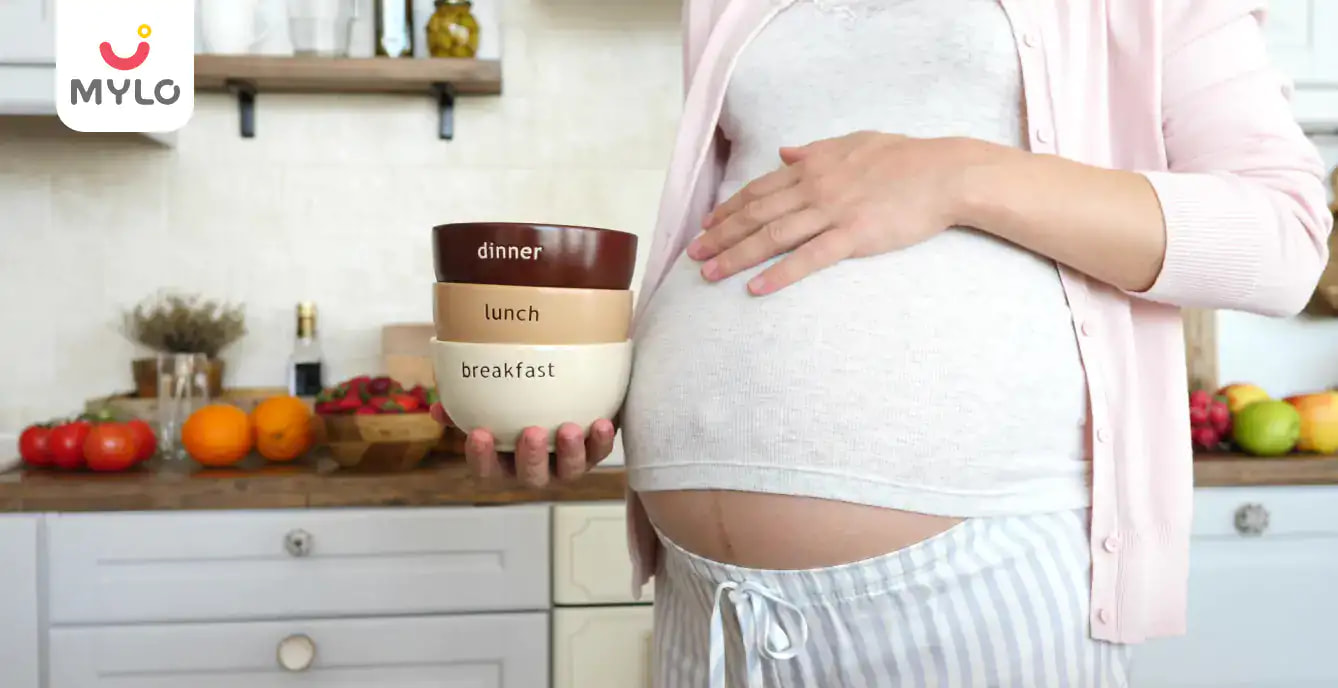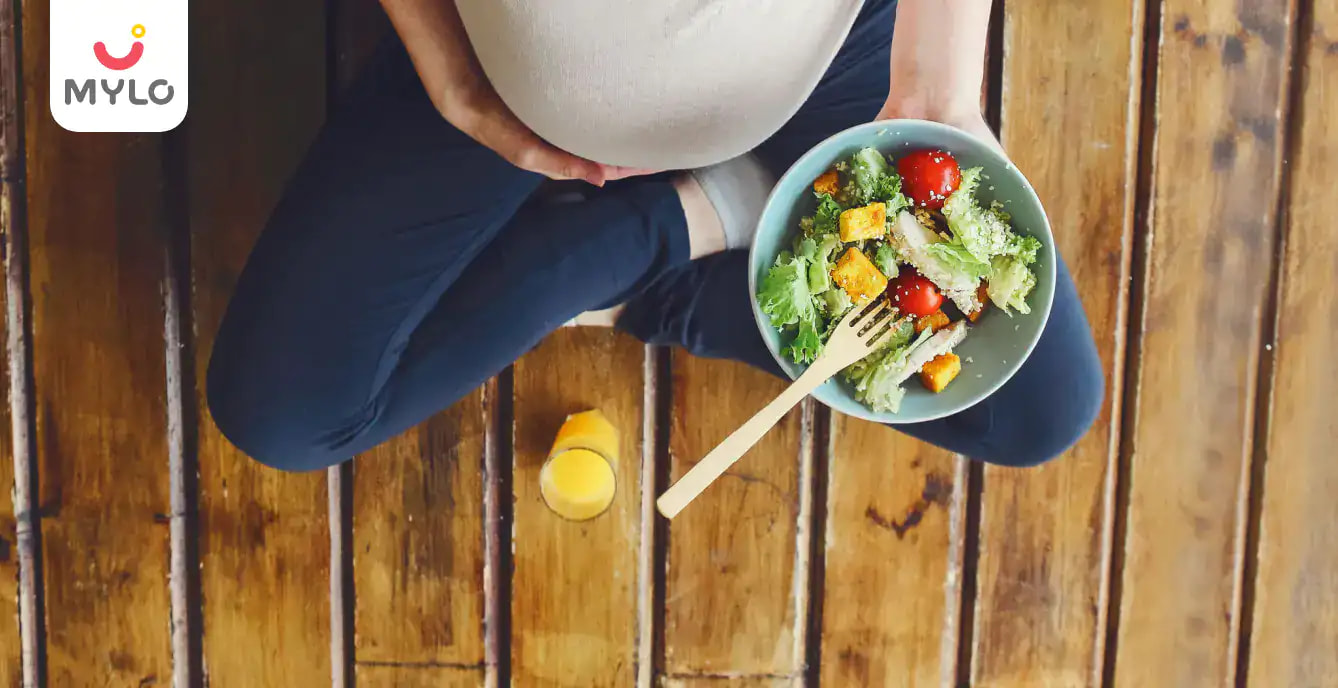Home

Diet & Exercises Your Wife Can Follow During Pregnancy
In this Article

Diet & Exercises Your Wife Can Follow During Pregnancy
Updated on 13 August 2023
At no point in time, would anything be more important or prominent than nutrition before and after pregnancy? Then again, ladies can in any case eat food varieties that arrive in a crate or a sack, eat out a few times each week, or request pizza to go as long as they likewise follow a couple of straightforward eating-for-two dietary rules.
Diet during pregnancy: tips
Maintaining a healthy and balanced diet during pregnancy is essential for your well-being and the development of your baby. Here are some important tips to consider for a nutritious diet during pregnancy:
1. Eat a Variety of Nutrient-Rich Foods
Include a wide range of foods from different food groups to ensure you're getting a variety of essential nutrients. Focus on whole grains, lean proteins, dairy or dairy alternatives, fruits, vegetables, and healthy fats.
2. Adequate Caloric Intake
Pregnancy requires additional calories, but it's important to focus on nutrient-dense foods rather than just increasing your overall intake. Aim for around 300-500 extra calories per day, especially in the second and third trimesters.
You may also like: What Is The Best Thing For Pregnant Women To Eat?
3. Folate and Folic Acid
These are crucial for preventing birth defects. Consume foods rich in natural folate, such as leafy greens, beans, and fortified cereals. Also, take a prenatal vitamin with folic acid as recommended by your healthcare provider.
4. Calcium and Vitamin D
These nutrients are important for bone health and the development of your baby's bones. Include dairy products, fortified plant-based milk, leafy greens, and fortified cereals.
5. Iron-Rich Foods
Iron is vital for preventing anemia and supporting the baby's growth. Include lean meats, poultry, fish, beans, lentils, fortified cereals, and dark leafy greens. Combining iron-rich foods with vitamin C sources can enhance iron absorption.
6. Omega-3 Fatty Acids
These are important for brain and vision development. Include sources like fatty fish (choose low-mercury options), flaxseeds, chia seeds, and walnuts.
7. Protein
Adequate protein supports the growth of your baby's tissues. Include lean meats, poultry, fish, eggs, beans, lentils, tofu, and dairy or dairy alternatives.
8. Hydration
Drink plenty of water to stay properly hydrated. Water supports digestion, circulation, and amniotic fluid levels.
9. Limit Processed Foods
Minimize your intake of processed foods high in added sugars, unhealthy fats, and excess salt. Opt for whole, minimally processed options.
10. Listen to Your Body
Pay attention to hunger and fullness cues. Your body will guide you on how much to eat.
Remember, a healthy pregnancy diet is about balance and making mindful choices. Consulting a registered dietitian or healthcare provider for personalized guidance is recommended to ensure you're meeting your nutritional needs for a healthy pregnancy journey.
What Exercises Are Safe During Pregnancy?
Engaging in regular exercise during pregnancy can provide numerous benefits for both you and your baby. It's important, however, to choose exercises that are safe and suitable for your individual health and pregnancy status. Always consult your healthcare provider before starting any exercise routine during pregnancy. Here are some generally safe exercises to consider:
1. Walking
Walking is a low-impact cardiovascular exercise that can be done throughout pregnancy. It helps improve circulation, maintain a healthy weight, and boost mood.
Also read: Simple Pregnancy Walking Workouts for Every Trimester
2. Swimming
Swimming and water aerobics are gentle on the joints and provide a full-body workout. The water's buoyancy reduces impact and supports your growing belly.
3. Prenatal Yoga
Prenatal yoga focuses on gentle stretches, breathing, and relaxation techniques. It can improve flexibility, balance, and help with relaxation and stress management.
4. Stationary Cycling
Using a stationary bike provides a low-impact cardiovascular workout. Adjust the intensity and resistance as needed.
5. Low-Impact Aerobics
Participate in low-impact aerobics classes specifically designed for pregnant women. These classes focus on cardiovascular fitness and muscle toning.
6. Pelvic Floor Exercises
Kegel exercises help strengthen pelvic floor muscles, which can improve bladder control and support during pregnancy and childbirth.
7. Stretching and Flexibility Exercises
Gentle stretching routines can help maintain flexibility and alleviate muscle tension.
8. Breathing Exercises
Practicing deep breathing and relaxation techniques can help reduce stress and prepare for labor.
9. Dancing
Low-impact dance classes or free-form dancing at home can be a fun way to stay active.
Also read: Squat During Pregnancy Benefits & Precautions
Tips for Exercising Safely During Pregnancy
Follow the tips given below to exercise safely during pregnancy.
1. Warm Up and Cool Down
Always start with a gentle warm-up and end with a cool-down period.
2. Stay Hydrated
Drink plenty of water before, during, and after exercise to stay hydrated.
3. Listen to Your Body
Pay attention to how you feel. If you experience pain, dizziness, shortness of breath, or any discomfort, stop exercising and consult your healthcare provider.
4. Avoid Overexertion
Avoid pushing yourself too hard. Pregnancy is not the time to set personal fitness records.
5. Avoid High-Risk Activities
Avoid activities with a high risk of falling, impact, or abdominal trauma, such as contact sports, skiing, and horseback riding.
6. Stay Cool
Exercise in a well-ventilated area and avoid overheating. Wear comfortable clothing and avoid exercising in high temperatures.
7. Pelvic Floor Care
Focus on maintaining good pelvic floor health by avoiding high-impact exercises that place excessive strain on these muscles.
You may also like: Who said you can't dance with your baby bump? It may be the best physical and mental exercise for you!
Remember, every pregnancy is unique, and your healthcare provider can guide you on the most appropriate exercise routine for your specific circumstances. Prioritize your safety and the well-being of your baby while staying active during pregnancy.
Conclusion
Counsel your medical services supplier before starting an activity program. Your medical care supplier can offer customized practice rules, in light of your clinical history.
References
1. Cooper, D. B., & Yang, L. (2021). Pregnancy And Exercise. PubMed; StatPearls Publishing.
2. Ribeiro, M. M., Andrade, A., & Nunes, I. (2021). Physical exercise in pregnancy: benefits, risks and prescription. Journal of Perinatal Medicine,
Tags



Written by
Priyanka Verma
Priyanka is an experienced editor & content writer with great attention to detail. Mother to an 11-year-old, she's a ski
Read MoreGet baby's diet chart, and growth tips

Related Articles
Related Questions
Hello frnds..still no pain...doctor said head fix nhi hua hai..bt vagina me pain hai aur back pain bhi... anyone having same issues??

Kon kon c chije aisi hai jo pregnancy mei gas acidity jalan karti hain... Koi btayega plz bcz mujhe aksar khane ke baad hi samagh aata hai ki is chij se gas acidity jalan ho gyi hai. Please share your knowledge

I am 13 week pregnancy. Anyone having Storione-xt tablet. It better to have morning or night ???

Hlo to be moms....i hv a query...in my 9.5 wk i feel body joint pain like in ankle, knee, wrist, shoulder, toes....pain intensity is high...i cnt sleep....what should i do pls help....cn i cosult my doc.

Influenza and boostrix injection kisiko laga hai kya 8 month pregnancy me and q lagta hai ye plz reply me

RECENTLY PUBLISHED ARTICLES
our most recent articles

Can a diet plan help deal with infertility in women and boost the chances of conception?

Pumping
How to Sterilize Breast Pump: A Comprehensive Guide for New Moms

Medications
Bronchiectasis Meaning in Hindi | ब्रोन्किइक्टेसिस क्या होता है?

Festivals & Celebrations
The Ultimate Guide to Teej 2023: Celebrations, Traditions, and Dates

Conception
Should I Pee After Sex if Trying to Get Pregnant? And 5 Other FAQs

Periods
Menorrhagia: A Guide to Understanding Heavy Period Bleeding (Part 1)
- Indigestion and Heartburn During Pregnancy
- Understanding Follicular Study: A Comprehensive Guide to Female Fertility
- Maternity Fashion: How to Dress in Style in Each Trimester of Your Pregnancy?
- Oligomenorrhea: What Every Woman Needs to Know About Irregular Periods
- Can a Woman with Thyroid Problems Get Pregnant: Conceiving Against the Odds
- Adenomyosis Vs Endometriosis: How to Spot the Symptoms and Seek Early Intervention
- Fertility Test for Men and Women: What to Expect and Next Steps
- Reason for Irregular Periods After Marriage: A Comprehensive Guide
- How Soon Can You Get Pregnant After Stopping the Pill?
- Watery Semen: Is It Normal or a Sign of an Underlying Condition?
- Embryo Transfer: The Ultimate Guide to Procedure, Success Rates and FAQs
- Hyperspermia: The Ultimate Guide to Understanding Excessive Semen Production
- Painful Ejaculation and Its Impact on Men's Health: From Stigma to Solutions
- Hypospermia: What Every Man with Low Semen Volume Should Know


AWARDS AND RECOGNITION

Mylo wins Forbes D2C Disruptor award

Mylo wins The Economic Times Promising Brands 2022
AS SEEN IN
















- Mylo Care: Effective and science-backed personal care and wellness solutions for a joyful you.
- Mylo Baby: Science-backed, gentle and effective personal care & hygiene range for your little one.
- Mylo Community: Trusted and empathetic community of 10mn+ parents and experts.
Product Categories
baby carrier | baby soap | baby wipes | stretch marks cream | baby cream | baby shampoo | baby massage oil | baby hair oil | stretch marks oil | baby body wash | baby powder | baby lotion | diaper rash cream | newborn diapers | teether | baby kajal | baby diapers | cloth diapers |








